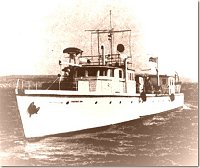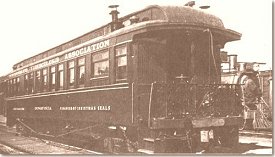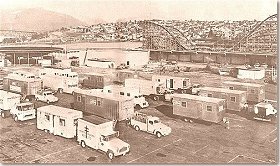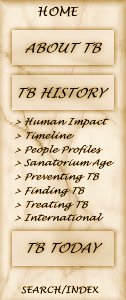|
Time Line of TB in Canada
|

|
1923 - Travelling Clinics Begin |

|
|
The M.V. "Christmas Seal" was a US naval boat purchased by the Newfoundland anti-TB league in 1947, and fitted with mobile x-ray equipment. Due to a lack of roads, a major portion of the population could not reach the screening centres, so this floating TB clinic came to them. |
The first travelling TB clinic was organized in Ontario in 1923, by the Ontario Provincial Board of Health, and the trend soon spread to every province in Canada. These clinics were capable of performing all of the functions required for a TB control program, including diagnosis, treatment, and follow-up for ex-patients and contacts.
At first, attendance at the clinics was confined for the most part to suspects, contacts, and patients referred by doctors and did not include the presumably healthy population. Soon, however, the clinics evolved into mass surveys in which entire populations were examined for TB infection. The development of mobile x-ray machines contributed to the ease and effectiveness of these surveys, allowing trained staff to quickly find evidence of tuberculosis in the bodies of people who had not yet begun to show external symptoms of the disease. Early discovery of the disease meant that treatment was far more effective and in this way, the mass surveys helped win the fight against TB in Canada.
|
|
|

|
|
During 1948, this railcar converted into a mobile x-ray unit named "Bonavista" helped discover 28 active cases of TB throughout settlements in Newfoundland. |
In 1941, the first Canadian mass survey for TB was conducted at the town of Melville, Saskatchewan, where 75% of residents were x-rayed. Later that year, Moose Jaw, Saskatchewan became the first city in Canada to institute an x-ray examination of all residents. Local organizations canvassed the city urging everyone to attend the clinics. Children were sent in groups from school to be x-rayed and the whole city council turned up one evening after a regular meeting. In the summer of 1948, during a mass TB survey of the city of Saskatoon, a record 95.5% of the available population showed up for screening. 41,082 out of a possible 43,016 people showed up at the fluorography vans to be checked for tuberculosis infection. The 3 survey vans shattered another record during the survey, putting through 4,489 persons in a single day. One van was responsible for 1,809 surveys, processing an average of 3.76 people per minute.

|
|
A fleet of mobile x-ray trucks lined up at the Vancouver PNE, ready to take on 'Operation Doorstep'. This first mass survey of the city of Vancouver required trucks borrowed from all over the country (ca. 1964). |
Mass surveys for tuberculosis, for which the province of Saskatchewan received international attention, relied heavily upon public participation in the fight against Tuberculosis. Every case of tuberculosis comes from another case of tuberculosis, and when one case of TB is discovered, steps can be taken to safeguard the entire community.
|
|




